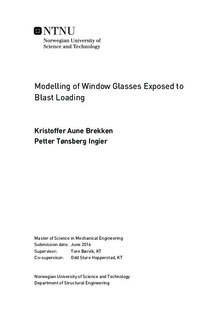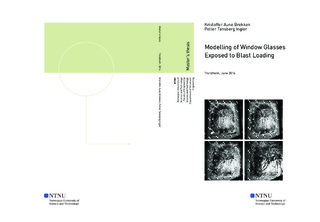| dc.contributor.advisor | Børvik, Tore | |
| dc.contributor.advisor | Hopperstad, Odd Sture | |
| dc.contributor.author | Brekken, Kristoffer Aune | |
| dc.contributor.author | Ingier, Petter Tønsberg | |
| dc.date.accessioned | 2019-09-11T08:34:47Z | |
| dc.date.available | 2019-09-11T08:34:47Z | |
| dc.date.created | 2016-06-10 | |
| dc.date.issued | 2016 | |
| dc.identifier | ntnudaim:15017 | |
| dc.identifier.uri | http://hdl.handle.net/11250/2614893 | |
| dc.description.abstract | Failure of window glasses in buildings subjected to blast loading introduces great potential for casualties and structural damage, primarily by the creation high velocity glass fragments. The application of laminated security glazing mitigates the risk in blast load scenarios by reducing the size and number of glass fragments projected from window panes. Glass is used extensively in building façades, and in order to design safer buildings, an improved understanding of the complex phenomenon of blast loaded window panes is needed.
In the work of this thesis, material tests to determine elastic behaviour and stochastic dispersion of failure strength in monolithic glass, were carried out. Blast tests in the shock tube facility at SIMLab on monolithic and laminated glass panes, have been conducted to study behaviour of glass exposed to blast loading. Point-tracking with DIC was used to determine deflection of glass panes and variations in boundary conditions. In addition, experiments to research boundary conditions in blast experiments were conducted.
Non-linear explicit simulations of material and blast tests have been conducted in the finite element code LS-DYNA. Material models with and without stochastic distribution of failure criteria have been used to model failure response in laminated and monolithic glass by element erosion. Numerical and experimental results have been compared, with emphasis on capturing the stochastic distribution of failure strength and fragmentation found in glass.
Good correlations between numerical simulations and material tests on elastic and failure strength for glass was found. Numerical models of blast tests were able to describe fragmentation and a stochastic distribution in material strength. However, the exact capacity of the tested monolithic and laminated glass were not captured in simulations. | en |
| dc.language | eng | |
| dc.publisher | NTNU | |
| dc.subject | Produktutvikling og produksjon, Industriell mekanikk | en |
| dc.title | Modelling of Window Glasses Exposed to Blast Loading | en |
| dc.type | Master thesis | en |
| dc.source.pagenumber | 200 | |
| dc.contributor.department | Norges teknisk-naturvitenskapelige universitet, Fakultet for ingeniørvitenskap,Institutt for konstruksjonsteknikk | nb_NO |

